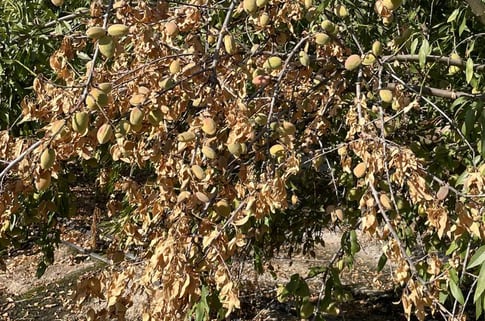Reducing Hull Rot Incidence in Almonds Through Nitrogen and Water Management


Managing hull rot incidence in almond orchards can be challenging. The pathogen will thrive in high vigor and well managed orchards, usually due to excessive irrigation and soil nitrogen during hull-split. Almonds require a significant amount of nitrogen during the season and a lot of water during the summer, a period where the trees are extremely sensitive to water stress, making it difficult to manage the pathogen. However, studies have shown that well managed strategic deficit irrigation (mild to moderate stress levels) and avoiding over fertilizing with nitrogen during the onset of hull-split have been shown to reduce hull rot while maintaining yield.
Hull Rot Infection
Hull-split usually happens around the end of June through the first week of July within the San Joaquin Valley. As hull-split progresses, it creates an inviting entry point for hull rot pathogens. There are three main fungi that cause hull rot: Monilinia spp. (airborne spore), Rhizopus stolonifera (soil fungus), and Aspergillus niger (soil fungus). These fungi are attracted to the nutrients and humidity in the hull that creates a microclimate that is ideal for the fungi to complete their life cycle. Once inside the hull these pathogens release toxins that move into the spur and shoots. Shriveled and dry leaves during the first few weeks of July may indicate that the hull is infected. Most susceptible varieties include Nonpareil, Butte, and Winters. Hull rot can limit the full potential of an orchard by killing the tree’s spurs, which produce the bloom for the following year. The damage can be extremely severe if the disease is not managed properly.
Importance of Nitrogen Management in the Control of Hull Rot
Nitrogen management has major impacts on the productivity of almond orchards. Excessive nitrogen within the tree will not only affect productivity but will also increase susceptibility to hull rot. High levels of nitrogen within the tree results in delayed maturation of hulls and lengthen the period during which hull rot infection can occur. Long term UC research trials showed that the more nitrogen applied, the higher the incidence of hull rot.
In almonds, nitrogen uptake from the soil closely follows the development of fruits and shoots, starting in March and reducing drastically after kernel weight accumulation is complete. Over 85% nitrogen uptake from soil has taken place by the end of this growth stage. From beginning of hull-split to three weeks post-harvest little nitrogen is needed. During this stage, the goal is to not “over-feed” trees especially in the period immediately after hull-split. Therefore, to minimize hull rot incidence in the orchard, growers should fertilize continuously at the right time and right amount in as many small applications as possible decreasing the amount as trees approach fruit maturity. The application of nitrogen in a few large single doses or the traditional three-to-four nitrogen applications in a growing season during times of limited tree growth results in temporary high soil nitrogen increasing the potential for hull rot.
In summary, nitrogen should be available for trees to uptake from 70% leaf out until three weeks post-harvest. Completely stopping nitrogen application in June to help control hull rot is not advised as it may deprive trees of nitrogen during the critical bud formation period as well as the time when trees begin to accumulate nitrogen supply to prepare for harvest. Nitrogen applications made more frequently and in smaller amounts along the entire season reduce instances of high nitrogen concentration in soil, thus reducing the incidence of hull rot. The ideal leaf nitrogen in July/August should be around 2.2-2.5%.
Strategic Deficit Irrigation to Manage Hull Rot
Almond trees can survive on as little as 7.6 inches of water, but they will reach maximum productivity with 54 to 58 inches of water. The severity of the stress will determine its effect on the tree and consequently on yield. Moderate to severe stress through June and July has been shown to reduce kernel weights by as much as 30%.
Mild to moderate stress however, if properly monitored, have been shown to reduce hull rot without impacting yield. The method of limiting water application during less critical periods of nut development is called strategic deficit irrigation. Tree water stress can be easily monitored by measuring midday stem water potential using a pressure chamber. Strategic deficit irrigation maintains full irrigation until completion of kernel fill. After kernel fill and until 90% hull-split, irrigation is applied only after trees reach stem water potential values of -14 to -18 bars. In the field, it can be difficult to adjust the irrigation schedule to this threshold. Many growers reduce water use by 50% around mid-June and adjust the quantity of recurring irrigations once stress levels increase and soil moisture depletion occurs. Adopting this irrigation strategy from post-kernel fill through 90% hull-split, a period of about two weeks, can reduce hull rot up to 90%. In addition, it can also help achieve a more uniform hull split, shorten length of hull split, and improve nut removal.
While fungicide applications are an option for managing hull rot, they are not the preferred approach. A single application at hull-split, timed with the navel orange worm insecticide treatment, may reduce hull rot incidence by 60 to 70%. Fungicide treatments should always be integrated into deficit irrigation and best nitrogen management practices during hull-split. Managing tree vigor through proper irrigation and nitrogen fertilization is the most effective control practice.
Blighted shoots caused by hull rot. Symptoms showed dieback of vigorous young shoots and lower limbs.
